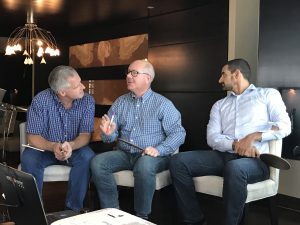How to Bond with your Colleagues in a Hybrid World
By Michaela Picones |
2.9 min read

This new hybrid working world has several advantages and disadvantages, the most troubling of which is how senior managers create rapport with their people. In this hybrid world, what does mentorship entail? What does leadership look like? For new team members and rookie workers, making connections is critical. As a senior leader, you need to take some time to develop systems that cultivate relationships, remote and on-site. This requires engaging more deliberately, providing clear expectations, and giving appropriate guidelines. Not doing so means running the risk of employee disengagement and jeopardizing productivity.
This past year, research at a large North American corporation demonstrated that Zoom chats with managers generate strong relationships for new employees. This research also shows that informal “virtual watercooler” sessions in which interns communicate with supervisors online on a regular basis have been shown to boost employee performance and happiness. However, as pointed out in a Forbes 2018 Forbes article entitled How to Build Real Relationships in the Virtual World, “it’s harder to connect on a human level with people when they exist in two dimensions on your computer screen or mobile device. You need to work extra hard to make sure you’re interacting in a way that allows you to build genuine, meaningful relationships.”
Building Meaningful Relationships in the Hybrid World
Transparency, Likeability, Credibility
These are the qualities that people look for when building professional relationships. People want to work and do so more efficiently when they have leaders and colleagues around them that display these qualities. In this new work world, you will have to demonstrate these qualities virtually and onsite. An example of a way of displaying transparency during these unprecedented times is sharing information with your employees – both the good and bad – on consistent communication channels.
Virtual Water-Cooler
In-office interactions are easily mimicked thanks to the technology we have at our disposal. However, we must match the digital tool with the kind of interaction we are looking to have.
- Conference room meetings go on the calendar as video conferencing events.
- 1 on 1s with managers take place via Skype, Zoom, MS Teams
- Water cooler talk is conducted over Slack.
- Email is used for the same purposes as it would be in the office.
Having clear communication channels allows individuals to know where they are free to have a random conversation or brainstorm sessions & allow meetings to stay on topic and purposeful.
Flexibility & Meaningful Work
After a year of being able to keep up productivity and proving that work from home can be done, dynamic and flexible work is now an expectation. The return to office can bring up mixed feelings for everyone involved. When asking people to come back to the office, the “butts-in-seats” mentality will have a lot of people angered. It’s time to rethink and think more deeply about the work activities within the organization. There are work activities that are better in person, work that requires collaboration and innovation for example. If you are asking your employees to come back to the office, make sure that the environment is one where relationships are nurtured and that the work activity that is expected of them is one that can be done well/better when everyone is around.
Looking to gain more insight into your employees? Find out how we can help here.
References:
Related Blogs
How to Decide Who to Layoff?
How to Decide Who to Layoff? A Strategic Guide Powered by The Predictive Index In uncertain economic climates, tough decisions often become necessary for business continuity. One of the most challenging decisions any organization faces
HR Risk Management – Full Guide
HR Risk Management: A Full Guide with The Predictive Index Advantage In today’s volatile business environment, human capital remains one of the greatest assets—and one of the biggest risks. Organizations are navigating an increasingly complex
9 Tips for Hiring the Best Salesperson
9 Tips for Hiring the Best Salesperson (Backed by The Predictive Index) Hiring the right salesperson can feel like trying to find a needle in a haystack. Sales is a high-stakes role where the right



